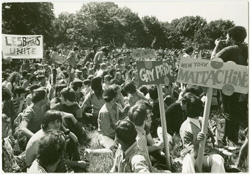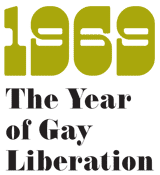Closing
 |
Pride in the Park
Gay "Be-In," Sheep Meadow, Central Park, New
York City, 1970. Photograph by Diana Davies.
NYPL, Manuscripts and Archives Division, Diana Davies Papers. Copyright Diana
Davies.
Digital ID: 1582244 |
Today's LGBT movement grew out of the activist organizations
that emerged in the fertile and tumultuous year that followed
the Stonewall Riots. Gay Liberation Front, Gay Activists Alliance,
and the Radicalesbians all sent small groups of activists on road
trips to spread the word. Chapters sprang up across the country,
and many outlived the original groups in New York City. These
groups in turn fought for civil rights in their home communities.
In the following year, GAA became a major activist force in New
York, fighting for civil rights legislation and opening a community
center in SoHo, their Firehouse, which became a nexus for New
York City gays and lesbians. The vision put forward by the Radicalesbians
took root and flowered into a dynamic lesbian feminist movement
across the nation.
The 1970s became a gay and lesbian renaissance with its own
literature, music, politics, and erotic presence. Gay, lesbian,
and transgender activists won major political victories, such
as the removal of homosexuality from the American Psychiatric
Association's list of mental disorders, and were able to apply
public pressure to combat negative stereotypes of homosexuality.
However, many of the challenges faced by Mattachine-era activists
still continue today, such as bans on military service and marriage
for gays, police entrapment, and the struggle of transgender people
for civil rights.
The march itself became an institution, with Gay Pride and
later LGBT Pride months celebrated around the world. Over time,
the march evolved, and the route changed from up Sixth Avenue
to Central Park, to down Fifth Avenue to the Village. As the many
ethnic parades in the city do for their groups, the annual march
demonstrates gays, lesbians, and transgender people as articulate
constituencies. It has become a living symbol of the evolution
of LGBT political communities.

